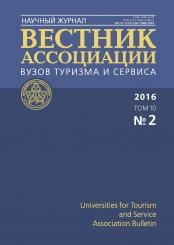Moscow, Russian Federation
The article deals with the network-centric management model for tourist destinations. The model is based on the use of modern information technology and the network system of the organization of information exchange between destinations and consumers of tourism services as well as marketing organizations. Networks are considered as «clusters» or aggregation structures consisting mainly of small and medium tourism enterprises that are using web technologies and modern market interaction and thus help each other (the principle of «B2B»), giving customers a complete package of tourism products and services. We consider the principle of self-synchronization in the construction management of network-centric destinations, allowing the tourist and recreation structures to organize themselves «from below» and not to be reformed administratively. In the framework of the synergetic approach the concept of«attractor of tourism and recreation» is introduced. It is shown that the development of this idea is associated with the concepts of the fluctuations of chaos, bifurcation, dissipation, diffusion of innovations, i.e. anew conceptual apparatus, including those notions related to the theory of catastrophes. It is concluded that the initial methodological basis for solving network-centric management problems of large tourist and recreation system is the principle of graph-dynamics representing a promising direction in management theory. The strategy of «borrowing» is elaborated with regards to the application of the mechanisms of diffusion of innovations and advanced technologies in the tourism and recreational tourism industries in the regions of Russia. It is concluded that the process of diffusion of innovation and advanced technology implies a large number of small and medium enterprises, as well as innovative infrastructure that will allow these companies to create effective cooperation ties in the field of tourism industry. A multi-network scheme is proposed for innovative development of tourist and recreational areas which includes an educational segment.
destination, information technologies, network management model
В последние годы активно развиваются теория и прикладная наука сетецентрического управления сложными системами как новая эффективная парадигма выживания современных социально -экономических структур в условиях масштабного применения инфокоммуникационных технологий и глобализации всех значимых процессов существования человечества [1; 2]. В основе сетецентрической парадигмы лежит сетевой принцип построения той или иной системы, позволяющий обеспечить максимальные возможности получении информации о параметрах ее собственного функционирования и состояния внешней среды, доступа к названной информации, ее обработки, хранения, распределения и обеспечения обратной связи [3; 4]. В эпоху продолжающейся информационной революции качественные скачки развития общества происходят, как правило, неожиданно, поэтому новые подходы к развитию социально-экономических отраслей необходимо формировать значительно быстрее, ибо потом лидеров догнать будет почти невозможно. Чтобы не постигать правоту этого постулата на своем печальном опыте,
1. Zatuliveter Yu.S. Na puti k global´nomu programmirovaniyu. Otkrytye sistemy. 2003. № 3. S. 46- 47.
2. Tanenbaum E., Van Steen M. Raspredelennye sistemy. Printsipy i paradigmy. Spb.: Piter. 2003. 877 s.
3. Zatuliveter Yu.S. Problemy globalizatsii paradigmy upravleniya v matematicheski odnorodnom pole komp´yuternoy informatsii. Problemy upravleniya. 2005. № 1. S. 1-23.
4. Zatuliveter Yu.S, Fishchenko E.A. Grafodinamicheskie sistemy s setetsentricheskim upravleniem v matematicheski odnorodnom pole komp´yuternoy informatsii. Upravlenie bol´shimi sistemami. Spetsial´nyy vypusk 30.1 «Setevye modeli v upravlenii». M.: IPU RAN, 2010. S. 567-604.
5. Buhalis D., Molinaroli E. Entrepreneurial Networks and Supply Communities in the Italian eTourism. Information Technology & Tourism, 1 January, 2003, Vol.5, No.3, PP. 175-184.
6. Buhalis D. Marketing the Competitive Destination of the Future. Tourism Management, 2001, No 21(1). PP. 97-116.
7. Bedritskiy A.B. Informatsionnaya voyna: kontseptsii i ikh realizatsiya v SShA. M.: RISI, 2008. 187 s.
8. Gubanov D.A., Novikov D.M., Chkhartishvili A.G. Sotsial´nye seti: modeli informatsionnogo vliyaniya, upravleniya i protivoborstva / pod red. chl.-korr. RAN DA. Novikova. M.: Izd-vo fiz.-mat. lit-ry. 2010. 228 s.
9. Nikolis G., Prigozhin I. Samoorganizatsiya v neravnovesnykh sistemakh. M.: Mir, 1979. 512 s.
10. KhakenG. Sinergetika. M.: Mir, 1980. 404 s.
11. Burkov V.N. Osnovy matematicheskoy teorii aktivnykh sistem. M.: Nauka, 1977. 255 s.
12. Gorodetsky A., Hyashenko Yu. Minimal and Strange Attractors//International Journal of Bifurcation and Chaos. Vol. 6, No. 6 (1996). PP. 1177-1183.
13. Avdeeva 3.K., Kovriga SV., Makarenko D.I. Kognitivnoe modelirovanie dlya resheniya zadach upravleniya slabostrukturirovannymi sistemami (situatsiyami) //Upravlenie bol´shimi sistemami M.: IPU RAN, 2007. № 16 (2007). S. 26-39.
14. Zernov V.A., Minaev V.A. Innovatsionnoe obuchenie i biznes-protsessy v mezhdunarodnykh setevykh sistemakh. Vysshee obrazovanie segodnya. 2013. № 6. S. 9-16.
15. Tunnel´nyy effekt http://elementy.ru/trefil/21195 (data obrashcheniya: 24.06.2014).
16. Evropeyskaya klasternaya observatoriya www.clusterobservatory.eu (data obrashcheniya: 24.06.2014).
17. Everett M. Rogers. Diffusion of Innovations, 5th edition. N. Y: Publisher - The Free Press, A Division of MacmiUan Publishing Co., Inc, 2003. 576 p.
18. Minaev B.A., Ovchinskiy A.C, Skryl´ SV., Trostyanskiy S.N. Kak upravlyat´ massovym soznaniem: sovremennye modeli. M.: RosNOU, 2013. 200 s.
19. Ekonomika kollektivnogo deystviya http://www.7iskusstv.com/2012/Nomer9/Majburdl.php (data obrashcheniya: 24.06.2014).





